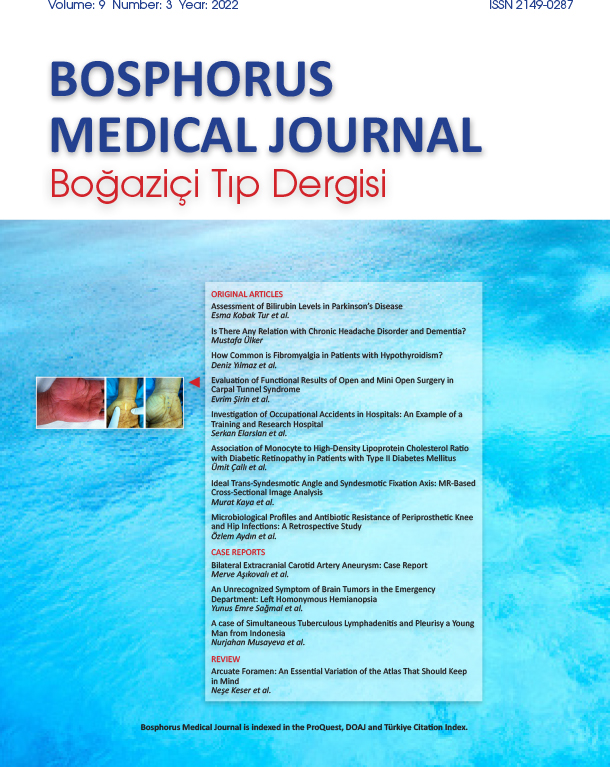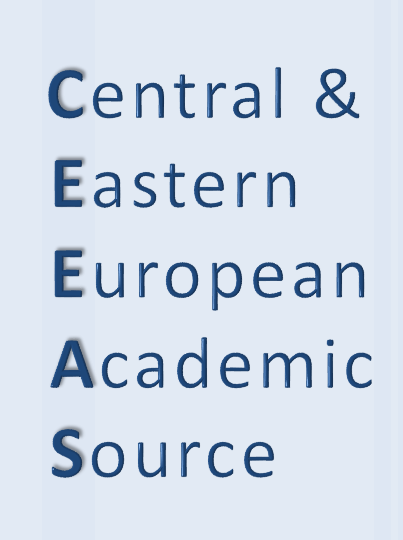Volume: 3 Issue: 3 - 2016
| ORIGINAL RESEARCH | |
| 1. | The Effects of Intravitreal use of Bevacizumab, Ranibizumab and Triamcinolone Acetonide Injections on Intraocular Pressure Tayfun Şahin, Yelda Buyru Özkurt, Mustafa Demir, Tuğba Gençağa Atakan, Gökçen Baş Eratlı Pages 76 - 80 INTRODUCTION: To examine the effects of intravitreal use of bevacizumab, ranibizumab and triamcinolone acetonide injections on intraocular pressure. METHODS: This study was conducted among the patients who applied intravitreal injection for various retinal pathologies (diabetic retinopathy, retinal vein occlusion, choroidal neovascularization etc.) in Ophthalmology Clinics of Fatih Sultan Mehmet Training and Research Hospital between February and May 2011. 20 bevacizumab (Group 1), 20 ranibizumab (Group 2) and 20 triamcinolone injected (Group 3) patients, 60 in total, were included in this study. The cases were examined before and after injections within the period of the first day, first week, first and third months. RESULTS: During the follow up period of cases, no significant change was found among three groups in terms of mean intraocular pressure average before the operation, within the first day and first week but in comparison to group 1, the average of intraocular pressure is found significant (p<0,01) in group 3 within the first (18,85 mmHg-14,25 mmHg) and third month (19,20 mmHg- 14,45 mmHg). Depending on time, a significant intraocular pressure difference was found solely in group 3. A significant intraocular pressure increase was found in group 3 in course of time but no significant difference was found in other groups. DISCUSSION AND CONCLUSION: Although intravitreal use of bevacizumab, ranibizumab and triamcinolone acetonide are effective agents in various retinal pathologies, triamcinolone acetonide may increase intraocular pressure. Thus, patients who are treated with intravitreal triamcinolone should be followed up closely after injection. |
| 2. | Skin Findings in Obstructuve Sleep Apnea Syndrome İlkin Zindancı, Hacer Kuzu Okur, Burçe Can Kuru, Mukaddes Kavala Pages 81 - 84 INTRODUCTION: Obstructive Sleep Apnea Syndrome (OSAS) is an important reason of morbidity and mortality due to repetitious hypoxia and axidative stres. In our study, we aimed to evaluate the skin findings of the patients who have diagnosed as OSAS. METHODS: We evaluated 475 patients those who were diagnosed by polysomnographic (PSG) assesement. Sixty-three patients aged between 18-55 years who have no systemic disease were included in the study. Patients demographic, laboratory and PSG findings were recorded. Dermatologic examination was done for all patients. RESULTS: All patients who were coming into line with the test study were all men, with a mean age 42.7±7.5, AHI: 29.4 ±19.3, BMI: 27.9±2.5, minimum okxygen saturation: 79.4±8.9, mean oxygen saturation: 93.1±2.7, oxygen desaturation index: 28.9±21.4. The most common dermatoses in dermatological examination were seborrheic dermatitis in 16 (25.3%) patients, contact dermatitis in 9 (14.2%) patients fungal infections in 8 (12.6%) patients and androgenetic alopecia in 8 (12.6%) patients. Inflammatory diseases such as seborrheic dermatitis, contact dermatitits and psoriasis were found in 25 (39.1%) patients. Relation between dermatological findings and OSAS was not found significant by statistically. DISCUSSION AND CONCLUSION: Recently it is claimed that oxidative stress may play a role in the etiopathogenesis of inflammatory dermatoses. The high incidence of inflammatory dermatoses seems in our study support this theory. |
| 3. | Evaluation of Demographic and Clinical Characteristics of Patients Presenting to the Emergency Department with Traffic Accidents Serdar Özdemir, Ebru Ünal Akoğlu, Taygun Baykal Pages 85 - 89 INTRODUCTION: Traffic accidents constitute an important part of the admission to the emergency department with trauma. The aim of this study; is to evaluate demographics, type of injury and our clinical approach of patients admitted to a third level education and research hospital after traffic accident in one year. METHODS: The clinical data of patients who admitted to department of emergency medicine after a traffic accident between 1.1.2014 and 31.12.2014 date were evaluated. Patient s data was reached by using computer- based data recording system. Age and gender of the patients were evaluated. The type of accident, requested tests; blood tests, radiography, ultrasonography (USG), computed tomography (CT), focused assessment with sonography in trauma (FAST) by emergency physician were evaluated. Systems affected by the trauma were grouped in head and neck, thorax, abdomen, upper extremity and lower extremity. The count of affected systems were classified; single system, multiple systems and not affected system. The number of consultation based on branches was evaluated. The count of consultations were grouped; 1, 2, 3, 4 and more. The ending of the patients grouped as; hospitalization, referral, discharge and death. Clinics where patient was referred and clinics where patient was hospitalizated were evaluated. RESULTS: 2492 patients were included in the study admitted to our clinic after a traffic accident in 2014. 1633 (66%) patients were male and 859 (34%) patients were female. The average age of the patients was calculated as 32.06 years. The 2492 patients in the study were 996 (40%) vehicle traffic accidents and 1496 (60%) nonvehicle traffic accidents.The count of affected systems were; 1413 (%26,7) patients single system, 916 (%36,8) patients multiple systems and 166 (%6,7) patients hasnt affected system. 973 (39%) patients were affected from head and neck, 1119 (44.9%) patients from lower extremities, 765 (30.7%) patients from upper extremity, 338 (13.6%) patints from abdomen and 317 (12.7%) patients from the thorax. Count of consultations were in 1310 (%52,6) patients zero, in 904 (%36,3) patients one, in 103 (%4,1) patients two, in 26(%1) patients three and in 49 (%2) patients four and more. Most requested consultation branch was orthopedics. The ending of patients were in 177 (%7,1) patients hospitalization, in 2297 (%92,2) patients discharge, in 8 (%0,3) patients death and in 2 (%0,1) patients dispatch. The clinic that hospitalized most of the patients was ortopedics. According to the seasons cases there is a statistically significant difference between the incidence. According to this information improving and planning of emergency services should be continued. DISCUSSION AND CONCLUSION: Traffic accidents plays an important role in the admission of emergency services. Consultation, laboratory tests and imaging hold an important place on process of the admission and discharge of patients. Public should be informed about pre-trauma prevention methods and appropriate trauma centers. Thereby earlier and more effective intervention could be provided for patients. |
| 4. | Effectiveness of Laser Therapy on Lateral Epicondylitis Nilgün Şenol Güler, Pınar Akpınar, Meryem Yılmaz Kaysın, Feyza Ünlü Özkan, İlknur Aktaş Pages 90 - 96 INTRODUCTION: Because of the conflicting results in the previous studies investigating the efficacy of low energy laser therapy (LELT) in the treatment of patients with lateral epicondylitis (LE), the effectiveness of the LELT was investigated in this study. METHODS: Fifty-seven patients between the ages of 18-75 years who were admitted to our outpatient clinic with elbow pain and diagnosed as LE were included in the study. The patients were randomly assigned to either the actual laser group or the placebo laser group. The patients were treated for 10 sessions with laser. We used Endolaser 422, laser probe one diod laser, LP025, Enraf Nonius for the treatment in the actual laser group. The same unit was used for the placebo laser group, in which no laser beam was emitted. Patients were evaluated at baseline, at the end of the therapy and one months later after the therapy. RESULTS: Placebo group was superior over actual laser group in terms of Moudley test, rigth hand grip force and left elbow pain pressure threshold at the end of the therapy. Actual laser group was superior over placebo group in terms of Cozen test, Moudley test, and rigth elbow pain pressure threshold one months later after the therapy. Laser group was also superior over the placebo group in terms of VAS rest, VAS movement scores, Patient- Related Lateral Epicondylitis Evaluation test (PRTEE) all of supgroups, and quick-DASH disability and work scores one months later after the therapy relatively. Both groups showed significant improvements in Mills test and VAS night scores at the end of the therapy and one months later after the therapy. Both groups did not show any significant improvement in the left hand grip strenght at the end of the therapy. Also, both groups did not show significant improvement in the left elbow pain pressure thresold at one month later after the therapy. There was no significant difference between the groups. DISCUSSION AND CONCLUSION: As a result of positive effects especialy on functional parameters, LELT could play a role in the treatment of patients with LE. |
| CASE REPORT | |
| 5. | Arterivenöz Fistüle Balon Katater Girişime Sırasında Oluşan Rüptürün Cerrahi Tamiri Cemal Kocaaslan, Tamer Kehlibar, Mehmet Yılmaz, Hüseyin Kuplay, Bülend Ketenci Pages 97 - 99 A functioning vascular access as an arteriovenous (av) fistula or an arteriovenous graft is a very important factor for patients undergoing hemodialysis on long-term survival and optimal quality of life. Percutaneous salvage is a possible treatment for occluded or stenotic segments of fistula but rupture can be seen as an important complication during these interventions. İn this case we reported a patient who had a rupture at venous side of the fistula during percutaneous intervention, ruptured was repaired surgically after failed percutaneous restoring technique. |
| 6. | Silikon Hidrojel Kontakt Lenslerde Pembe Renk Değişimi: İlk Tecrübe Sezin Akca Bayar, Dilek D. Altınors, Leyla Asena Pages 100 - 102 A twenty-six year-old female patient with the diagnosis of multiple sclerosis (MS) who was on interferon beta-1b therapy applied for pink appearance of her eyes when she wore her contact lenses. She was treated for multiple sclerosis and that she was recieving systemic interferon beta-1b treatment subcutaneously for the last two weeks. On followup, although she didnt use additional medication, her newly fitted contact lenses were stained likewise with the pink color under interferone treatment. There was no report in the literature about pinkstaining of contact lenses due to systemic medication. As the use of drugs like systemic interferone increases, its good to inform contact lens users about such a side-effect. |
| 7. | Role of the Magnetic Resonance Imaging in Diagnosis of Carsinoma Arising in Urinary Bladder Diverticula Hüseyin Özkurt, Işık Gülcan, Güzide Toksoy, Ender Uysal, Müjdat Bankaoğlu, Muzaffer Başak Pages 103 - 108 The most frequent site for urinary tract cancers is the urinary bladder. Neoplasms originating in bladder diverticula are characterized by early transmural invasion and a tendency for higher histopathological grades which rise mortality and morbidity. The final diagnosis of bladder cancer is usually established with pathological findings provided from cystoscopy and biopsy of the lesion. Intradiverticular tumors cannot always be visualized in cystoscopy because of narrow diverticulum orifice or bladder base location of the diverticulum. These methods also cannot detect extravesical disease. Moreover, the cystoscopy procedure can cause iatrogenic injury in the urethra or bladder. Magnetic resonance (MR) imaging of the bladder provides direct multiplanar capabilities and soft-tissue contrast. MR has also capable of showing tumor existence and extend in diverticula of the bladder. Contrast administration helps to distinguish tumor borders from the adjacent tissues. Our aim of the study was to assume the role of MR imaging in diagnosis of carsinomas arising in urinary bladder diverticula. |
| 8. | Complex Regional Pain Syndrome: Two Case Reports Kübra Neslihan Kurt, Pınar Akpınar, Feyza Ünlü Özkan, İlknur Aktaş Pages 109 - 112 Complex regional pain syndrome (CRPS) is characterized by swelling, pain, skin changes and vasomotor instability of the affected extremities. The pathogenesis is not completely understood, multiple hypotheses have been suggested and several predisposing factors have been identified. Clinical diagnosis is usually based on symptoms and physical findings. We report two cases of CRPS which involve knee after total knee artroplasthy and index finger after needle stick injury. In this report, we aimed to reveal the importance of early recognition of CRPS, as delay in diagnosis and proper treatment may have detrimental effect on the functional outcome. |
| REVIEW | |
| 9. | The General Approach to Low Back Pain in Child and Adolescent Age Groups Özge Gülsüm İlleez Pages 113 - 117 Contrary to the common belief, low back pain is a common condition in children and adolescents. Incidence varies due to age, gender and activity level of the patient. It is seen more frequently in older children and adolescents than younger children and in girls rather than boys. The most frequent reason is mechanic conditions like in adults. However in the etiology trauma, infection, malignancy, neurologic and rheumotological diseases should also come to mind. Taking appropriate anamnesis from the child and the family and a careful physical examination is very significant for the diagnosis. If necessary laboratory and imaging technics may be supportive. Mostly conservative treatment options provide treatment. |




















